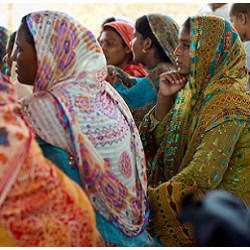
Information and communication technology (ICT) interventions are increasingly being used in developing countries to enable economic growth, employment, and empowerment. There is, however, growing agreement that the impact of ICTs in the Global South is not gender neutral but amplifies the existing gender inequalities within these countries.2,7 This is also true for Pakistan and India, where most ICT interventions deployed have largely ignored the unique needs of the female Pakistani (48.63%) and Indian populations (48.53%). Multi-country research on the impact of ICTs reveals their great potential for bringing about positive socioeconomic change and gains in economic growth.9 Similarly, studies reveal ICTs are one of the main drivers of economic growth in Asia, the Middle East, and Sub-Saharan African.3,8 However, in order to ensure entire populations benefit from the deployment and adoption of ICTs an understanding of the specific needs and challenges faced by women is imperative.
Given the patriarchal structures that constrain women in Pakistan, traditional Western digital solutions do not work. Detailed ethnographies reveal specific cultural, religious, and social contexts ICT interventions must design around. We explore the specific needs and constraints of low-literate, low-income women in Pakistan and tackle the gendered design of technologies for financial inclusion, maternal healthcare, and digital social connectivity.
Financial inclusion refers to a process that ensures ease of access and affordability of financial services for a population and is an important means to tackle poverty and inequality. Financial exclusion is a crucial issue facing women in Pakistan, which is on the list of seven countries that constitute half of the unbanked population around the world where only 7%a of women are included in the formal financial sector (have access to financial services) compared to South Asia’s average of 37% (in contrast, 76% of women in India own bank accountsb). In India, the main driving force behind increases in financial inclusion has been the ‘Jan Dhan Yojana’ scheme that mandated state-owned banks open at least one account for every unbanked household.
Given the patriarchal structures that constrain women in Pakistan, traditional Western digital solutions do not work.
Although digital financial services (DFS) are presented as a viable alternative to formal banking structures for the developing world, we show the concept of DFS, as it stands currently, is unsuited to the financial needs of Pakistani women. Unlike the developed world, mobile banking in Pakistan must account for phones as shared resources, secret/hidden financial transactions (women hide money from family/spouse), flexible and self-determined savings, and loan and dowry dynamics.7 In the Western context, mobile phones are considered and designed for use as personal devices, unlike Pakistan where only 39% of women own mobile phones.7
Another crucial area where ICTs have great potential for impacting women’s lives is healthcare. More than half a million women, 99% of them in developing countries, die each year from pregnancy-related causes, of which Pakistan alone is responsible for an estimated 30,000 deaths.c Large parts of Africa have tackled this using mobile phones to run services like MoTech and Abiye to deliver maternal and child health information.5,6 Similarly, in Pakistan, we have launched mobile-phone-based information systems to give low-income mothers access to critical pregnancy information. Based on qualitative interviews with doctors and pregnant mothers, we designed and launched a combination of SMS text messages and interactive voice response (IVR) system that provides critical information for maternal care. Impact evaluations of the system reveal that targeted messaging has the largest, statistically significant impact on pregnancy-related knowledge.4
A key issue faced by women in Pakistan is the lack of digital social connectivity. This is because all social media is based on the assumption of literacy and Pakistan is a country with an overall literacy rate of 58%; the literacy rate of women is 48%.
Another key issue faced by women in Pakistan is the lack of digital social connectivity. This is because all social media is based on the assumption of literacy and Pakistan is a country with an overall literacy rate of 58%; the literacy rate of women is 48%. To solve this, we have launched voice-based community forums accessible over feature phones that function as social networks and allow women to anonymously create, enjoy, and share content.1 Such social inclusion for women has allowed them greater connectivity and access to entertainment, education, and health opportunities.
Although our work has revealed essential guidelines for designing for women in patriarchal contexts some challenges remain. One open challenge is designing applications for shared mobile phones keeping in mind privacy for women in patriarchal contexts. Almost all applications, like mobile banking, email, Facebook, or Whats-App work on the assumption of a single user associated with a SIM. This is not true in Pakistan, where one phone/SIM is used by an entire family. How then, do you design and ensure privacy for each user? Similarly, given the harassment on voice-based social platforms that women face, how do you encourage female inclusion on these platforms?



Join the Discussion (0)
Become a Member or Sign In to Post a Comment